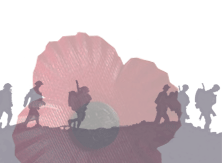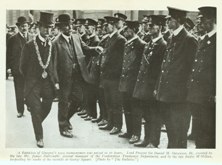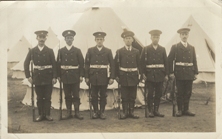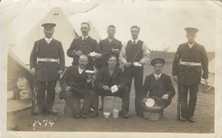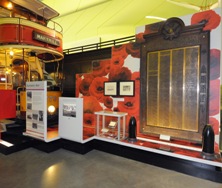George Cockburn
Their names will be remembered for evermoreAt Christmas 1915, a tram driver from Possilpark sent a postcard to his wife with a picture of a mother and baby, dreaming of their absent soldier. George Cockburn wished his family a merry Christmas from the front line, and wondered how his children looked now. It was one of his many tender letters home, and he was one of many thousands of volunteers who had willingly traded their day job for the trenches. When war was declared on Germany on 4 August, 1914, the government realised the army's numbers needed an immediate boost. Lord Kitchener, the Secretary of State for War, decided to raise an army of volunteers. Units were formed, grouping men according to their background or occupation. A New Army The notice that called up tram workers, two days after war was declared, was understated to say the least: "We are sorry that circumstances have arisen under which you have had to change your uniform this morning." About 500 reservists were called up, but in response to an appeal by the war office, the Lord Provost Sir Daniel Stephenson recommended at least two battalions be raised by the city. Within days, more than 1,100 men from the tram service had applied. Across the city, more than 15,700 Glaswegians had enlisted in what was known as Kitchener's New Army. On 7 September, the Glasgow Tramwaymen's Battalion marched to the City Chambers, led by a pipe band as crowds cheered. The 15th (Tramways) Battalion was attached to The Highland Light Infantry, along with similar volunteer units. Letters Home George Cockburn enlisted in 1915 and soon became a lance corporal. During training in Wiltshire, he began sending postcards home to his wife Mabel, and their children, Agnes, George, Mary and Willie. Agnes wrote back, "Dear Daddy, thank you for the flags, I wish you was home to make something for me, love from Aggie." By December, he had arrived at Martinsart near the Somme. He spent Christmas in billets at Aveluy, before going back to the front line. In his card picturing the mother and baby, Cockburn writes: "Is this anything like wee Willie. Hope you will have a merry Christmas." The battalion moved between their quarters and the front line at Bouzincourt. On a card showing a British and French soldier sharing a flag, Cockburn writes, to his son George: "I have got through this first spell of the trenches. How is Marnie [Mary] and Aggie and Willie, are you looking after them, did Santa Claus come... I would have like to see you... be a good boy till I come back and we will have a great time. Ta ta for now, love from Daddy." By April 1918, only 60 of the original 1,100 tramwaymen remained. On 3 April, D, B and C Companies were sent to capture the village of Ayette, near Arras. They prepared for battle for two hours, before the order was given to attack at 2am. In the following hours, over a dozen machine guns were captured, but casualties totalled well towards 100. Among these was George Cockburn, his battle for survival over. He was 33. Cockburn was posthumously awarded the Belgian Croix de Guerre. He is buried 12 miles from Arras. In Glasgow a memorial to the 15th Battalion The Highland Light Infantry was unveiled in 1933, with Cockburn's name among the 671 lost. Mabel died in 1934, while their son George - Cockburn's "good boy" - was killed in action in 1944. View original referenced text here: |
Images:
|






